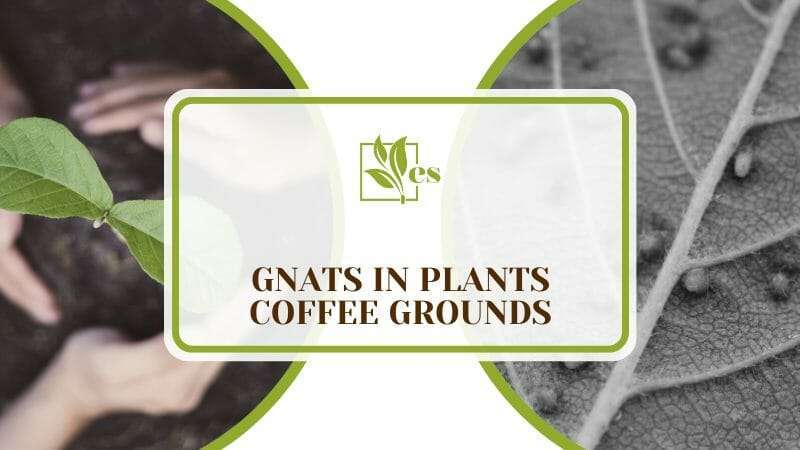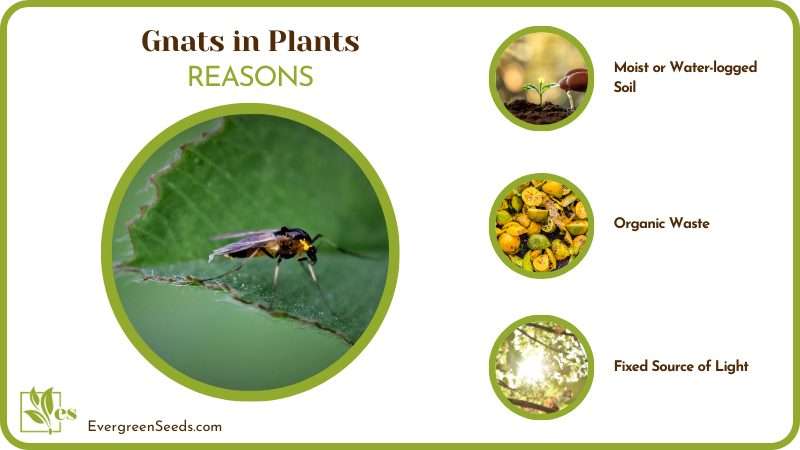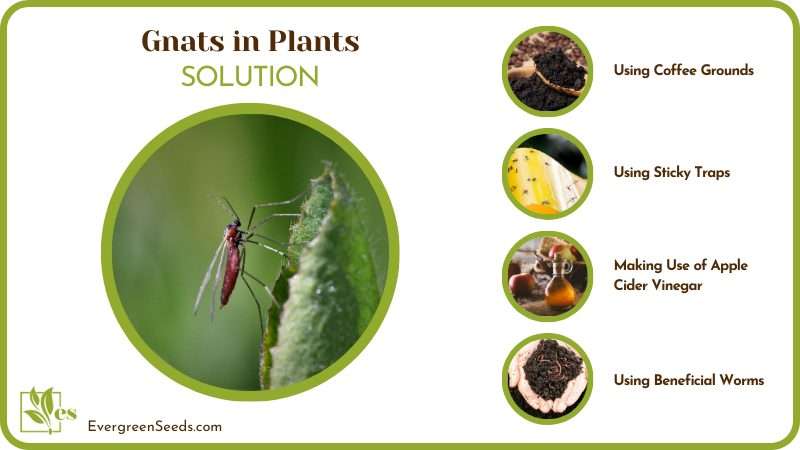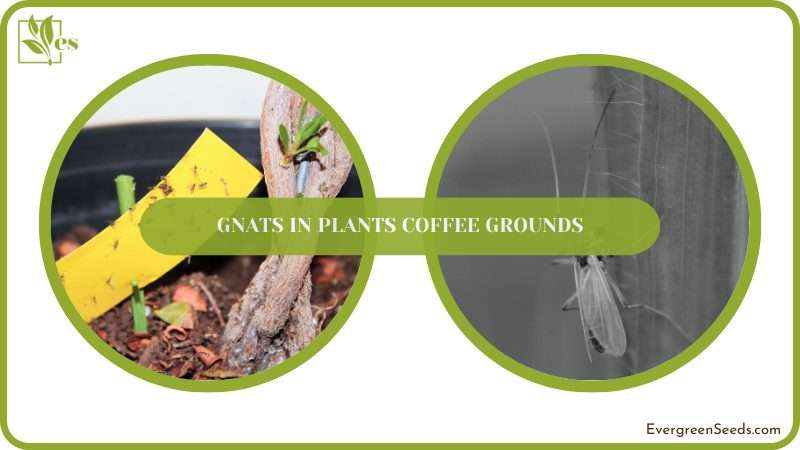Gnats in plants coffee grounds are one of the key elements to get rid of these pests that would damage your greens. However, just spreading the dried coffee ground on the surface of the soil won’t do, and doing that might even increase the spread of these pesky pests.

There are several other ways to get rid of gnats, and we will get into them in this article, read it all and you will find out.
What Causes Gnats in Plants?
Gnats in plants are caused by moist or water logged soil, or it can be due to organic waste accumulation. On another note, it can also be due to a source of light that has been fixed upon the plant for a long time.
– Moist or Water-logged Soil
Water-logged soils have the best conditions for gnats to grow and breed. If you’ve noticed that the soil in your plant pot is constantly wet and not properly drained, this might be a cause for your gnat infestation.
Note that as you increase the quantity of water, your plant will start to be in a highly humid environment, more than the necessary. Hence, this medium is perfect for the fungus to develop and to increase in their number and the damage will grow even more.
– Organic Waste
Leaves constitute organic wastes, which are a natural food source for the fungus gnats larvae. As a result, an abundance of organic debris in the soil creates a conducive environment for them to thrive.
So having a pile of organic waste in your potting soil will attract these pests, because the smell will be welcoming them and they will feed on this pile of fertile compost, and develop.

– Fixed Source of Light
Gnats are attracted to light. They are drawn toward light fixtures or natural sources of light in homes. If your indoor plants are placed close to any natural light source like through a window or light fixtures like lamps for example, the tiny insects flying around them are likely gnats.
How To Eliminate Gnats in Plants?
To eliminate gnats in plants, you can always use coffee grounds, sticky traps, use apple cider vinegar, or even make use of potato traps. In addition, you must change the soil completely and add beneficial worms. Also, use fungicides, mosquito dunks, simple chemicals, and stop overwatering the plant.
– Using Coffee Grounds
Many people will argue that coffee grounds aren’t effective in getting rid of gnat problems. This can’t be farther from the truth. Your success or failure with this method depends on the process and technique you used to apply the coffee grounds, as it is a natural way to get rid of them.
When these fungi establish a colony in your potting soil, the only way to get rid of them is to control their numbers and stop their breeding process. This is where coffee grounds come into play. Coffee grounds repel pests. Most pests do not like the smell of coffee, so they will stay away- Fungus Gnat is no different.
If your coffee grounds are not repelling them, you’re not doing it right. One thing you would have to do is to avoid spreading the coffee grounds on the face of your potting soil.
Spreading the coffee on the soil’s surface does your plants more harm than good. This is because the coffee grounds can quickly become moist and create a conducive environment for the growth of bacteria and fungus gnats.
What you want to do is to mix the coffee grounds with compost and some plant nutrients before adding the mixture to the soil- and only a small amount at that. Doing this will give you the best gnat-repelling results.
– Using Sticky Traps
Using sticky traps, like yellow, red, and yellow sticky notes, covered in adhesive works wonders in trapping adult pests. These pests fly erratically, and for some reason, they seem to be attracted to bright colors. The sticky some notes will trap the pests once they fly into it. Once they are trapped, surely, they’re not going anywhere.
The sticky note trapping method ensures that adult ones are unable to breed once they’re trapped. Hence, the population of the pests will keep reducing until they’re entirely gone. Simply secure the sticky notes directly above the larvae-infested soil, and watch the entrapment happen.
– Making Use of Apple Cider Vinegar
Apple Cider Vinegar works wonders for trapping different pests, including Fungus Gnats. They are attracted to the smell of Vinegar. If you don’t mind its smell, you can use apple cider to get rid of gnats in no time. Mix equal volumes of apple cider vinegar and some water in a bowl, and add about three drops of liquid soap.
Finally, place the mixture at the base of your plant and watch the magic happen. It’s important to repeat the process as often as it will take to get rid of the gnats.

Nonetheless, note that using wine works just like the apple cider vinegar trap, as the solution of both has been fermented. What’s more is that you don’t have to waste your perfectly good wine to do this-you can use an expired bottle of wine.
All you need is some of the expired wine mixed with liquid soap in a bowl, and place it next to the plant. This fermented juice will attract fungus, and the soap in the mixture will trap them, and they won’t prosper any longer.
– Using Potato Traps
You may also use potatoes to get rid of these fungi if you don’t have anything else on hand. All you must do is cut them up and place them in the gnat-infested soil. Fungus gnat larvae will move toward the moisture from the cut potatoes and feed on them. After a while, you can take them out and repeat the process.
Gnats have a very short life cycle-adults live for about a week. This short life cycle makes it easy to get rid of them. The famous saying “prevention is better than cure” is apt, especially with the slices of potatoes. With some easy precautions and elimination methods, you can ensure that you never have to worry about gnats.
– Change the Soil Completely
To get rid of gnats from house plants, consider uprooting the plants and cleaning out the soil from the pots.
Be careful with the roots of the plant, and clean the pot thoroughly with hydrogen peroxide or rubbing alcohol after emptying it to disinfect it. After doing this, you can fill the pot with fresh soil, throw the inferno away, and replant your houseplant in a successful manner.
Adding a layer of dry sand is less effective in getting rid of gnats than the other methods, but doing this has a way of drying out the infected soil. Thereby making the soil condition unconducive for the gnat eggs to hatch.
– Using Beneficial Worms
Using Beneficial worms, like nematodes, is the most natural and an effective way to that you can get rid of fungus gnats in very little time, you can mix them in the soil as they won’t harm the plant.
Nematodes attack gnat larvae and feed on them without causing any damage to your plants- an added bonus is that they won’t become a nuisance too. You can leave them in the soil as they ensure the gnats do not return, and these plants will be the keen protectors of the plant.
– Using Fungicidal
Neem oil is a natural insecticide that you can use to treat fungus infestation. Neem oil can be combined with other liquids to form a mixture.
This mixture of compounds two tablespoons of oil, a liter of water, and a little dish soap to emulsify the solution. Unlike the Vinegar treatment, you’ll need to pour or spread the neem oil mixture directly into the affected soil, as you would typically water your plants.
The only downside to using neem oil is that some plants might react to it. So, be sure to do a little test beforehand or do some research about your plants’ reactions to neem oil, if any, hence you can also spread it on a lower quantity as well, as it may be further diluted.
On the other hand, you can also use Diatomaceous earth or DE as a fungicidal, which is an excellent way to kill fungus gnats. It is a natural pest and insect deterrent. The great thing about it is that it isn’t toxic to plants.
All you need is food-grade the diatomaceous earth component, which is the safest for plants, and the affected soil. Let the soil dry out, and then sprinkle a thin layer of the powder on the surface of the affected soil, and the pests will be gone good.
– Using Mosquito Dunk
Yes, you read right, using mosquito dunk, although, this mosquito dunk is probably different from the one you’re thinking about, because it is a larvicide. It uses bacteria known as “Bti” to kill the larvae of fungus gnats in the soil.
What you must do is to soak the dunk in water for a while and pour the water into the soil, as you would normally wet your plants. You can get mosquito dunks from any pest control store.
– Using Simple Chemicals
You can treat your soil with dilute concentrations of hydrogen peroxide to eliminate gnats. Treatment with hydrogen peroxide is very effective. Mix three percent hydrogen peroxide with water in a ratio of 1:3 and pour the mixture into the gnat-infested soil.
On another note, you can also use Epsom salt on gnats. The salt consists of magnesium sulfate, which will destroy gnats and remove all traces of them as soon as the pests come into contact with it.
A simple solution of Epsom salt and water will do the trick, especially for severe infestation problems. Although, like with many other chemical compounds, you should do a patch test to check if Epsom salt is safe for your plants.
However, another easy way to get rid of adult gnats is to spray them with a mixture of soap and water. Additionally, you can spray your plants with a mixture of oil scents that gnats hate and water, or strong insecticides. However, some insecticides and oils might not be safe to use around your plants.
– Avoid Overwatering Your Plants
Fungus gnats thrive in moist or waterlogged soil. As a result, it’s best to avoid overwatering plants. Water plants about once a week to keep the soil dry enough that it doesn’t attract gnats but moist enough for the plant to survive. Leave some time between your last and next watering.
Also, you use a pot that drains well to prevent overwatering, note that a proper drainage prevents water-logging in flower pots. Get pots that have holes at the bottom to allow water to pass through. As fungus gnat larvae thrive in water-logged environments, they won’t survive in well-drained soils.
– Light Scented Candles
Gnats, like some other insects and pests, strongly rely on their sense of smell, and as a result, there are some scents that they hate.
These scents help repel fungus gnats, and most of them are usually in the form of oils and can be diluted with water and sprayed on gnat-infested plants or the surrounding areas. Some of these scents include; lemon, vanilla, lavender, citronella, peppermint, and eucalyptus.

While these scents don’t kill gnats, they help to deter them and keep them at bay. Also, if you have candles with any of these scents, you can light them up around the house to deter gnats.
– Place Carnivore Plants
Definitely! There are plants that you can grow in your home garden that have double functions. They beautify your home and have the added benefit of repelling fungus gnats and other insect pests. The best plants for this job are carnivorous plants, especially the flypaper or sticky paper types.
Some examples of carnivorous flypaper plants include; Sundew, Butterwort, and Dewy pine. These plants produce sticky substances that can trap flying insects when they come close enough to perch. With some time and patience, your flying gnat problem can be solved by placing a few of these plants around your garden.
References
- Raymond A. Cloyd, Andrew G. S. Cuthbertson. (2015 Jun). Ecology of Fungus Gnats (Bradysia spp.) in Greenhouse Production Systems Associated with Disease-Interactions and Alternative Management Strategies. National Library of Medicine
Retrieved from https://www.ncbi.nlm.nih.gov/pmc/articles/PMC4553482/ - Raymond A Cloyd. (June 2015). Ecology of Fungus Gnats (Bradysia spp.) in Greenhouse Production Systems Associated with Disease-Interactions and Alternative Management Strategies. ResearchGate.
Retrieved from https://www.researchgate.net/publication/275227756_Ecology_of_Fungus_Gnats_Bradysia_spp_in_Greenhouse_Production_Systems_Associated_with_Disease-Interactions_and_Alternative_Management_Strategies - J.A. Bethke, S. H. Dreistadt. Pests in Gardens and Landscapes. University of California.
Retrieved from http://ipm.ucanr.edu/PMG/PESTNOTES/pn7448.html












